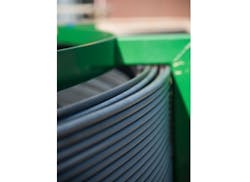| Ziebel's Z-Rod distributed sensor consists of a 15-mm-diameter flexible carbon-fiber composite rod containing embedded fiber-optic sensing lines. (Image: Ziebel) |
Ziebel (Houston, TX), which produces composite-rod well-intervention systems containing fiber-optic sensors, has completed its 100th distributed fiber-optic sensing job in which its Z-Rod system was deployed. The system consists of a 6500 m carbon-fiber composite rod with embedded fiber-optic lines that make it possible to deploy both distributed temperature and distributed acoustic sensing along the complete wellbore.
The rod, which has a diameter of 15 mm, is injected into the well using coil-tubing-like surface equipment and can travel up to 1800 m along the horizontal section of a well. Unlike traditional logging tools that can only survey a few inches of the well at a time, this type of sensing provides a complete wellbore profile that is captured several times per second.
The 100th job was performed for ConocoPhillips in the United States to determine the flow profile of zones within a fracked unconventional well.
"As operators of unconventional wells strive to improve recovery factors and reduce well costs, the data to enable this is becoming more critical," says Francis Neill, CEO of Ziebel. "Ziebel's ability to deliver this data across the reservoir is driving our increased activity levels."
According to Ziebel, the Z-Rod’s small diameter results in reduced choking effects versus traditional coil tubing, enabling the Z-Rod to determine which perforated zones along the length of the wellbore are actually contributing to production. This information allows unconventional field operators to optimize their completion strategies.
The 100 jobs were carried out using both land and offshore units in Norway, Denmark, Oman, Abu Dhabi, and the United States. Applications ranged from the evaluation of flow in unconventional wells to well-integrity diagnosis, monitoring water-injection schemes, gas-lift optimization, and understanding interwell communication and interference.
Source: Ziebel
